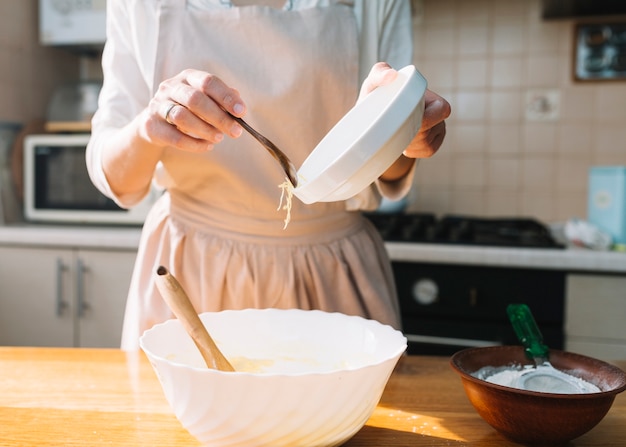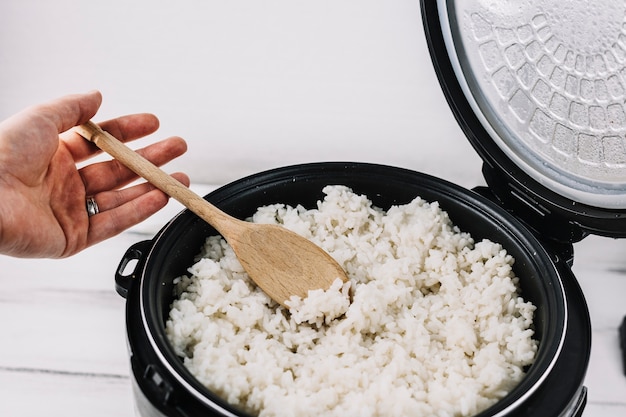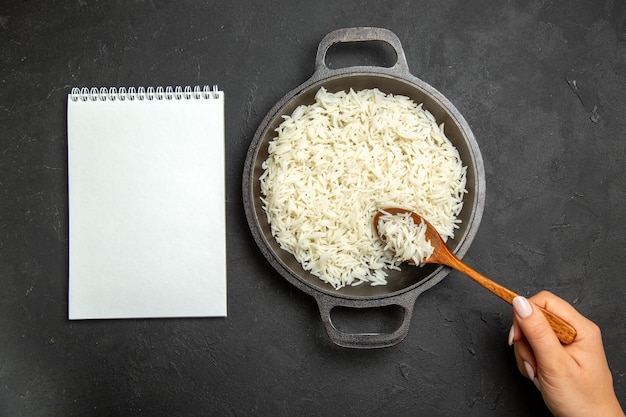Confession time: I used to be a bit of a rice disaster. You know the drill—sticky clumps, dry patches, endless stirring, and a simmering frustration. I'd spend hours scouring recipe websites, desperately seeking the magic formula for perfect rice. But it felt like every attempt ended in a culinary catastrophe.
Then, like a beacon of hope in a stormy sea of burnt rice, came the rice steamer. It was a revelation! Suddenly, my rice game was elevated to a whole new level. No more frantic stirring, no more burnt pots, just fluffy, perfectly cooked rice every single time. It's honestly changed my life (or at least my dinnertime).
Today, I want to share my love affair with the rice steamer and help you discover its magic too. From choosing the right steamer to mastering the art of fluffy rice, we'll explore everything you need to know to become a rice-cooking extraordinaire. So grab a cuppa, settle in, and let’s get cooking!
(Part 1) Why Rice Steamers are the Best: A Love Letter to Fluffy Rice

Let's be honest—stovetop rice cooking is a gamble. You're constantly hovering, stirring, and hoping for the best. But the rice steamer? It's a culinary superhero, saving you from sticky rice nightmares and offering a stress-free way to achieve perfection. Here's why it's my go-to kitchen companion:
1. Effortless Cooking: The Art of Setting it and Forgetting It
The rice steamer is the epitome of effortless cooking. Simply toss the rice in the bowl, add the right amount of water, press "start," and let it work its magic. No need to stand over the stove, constantly stirring, or worrying about burning. It's so easy, even my cat could do it (though I wouldn't recommend letting him).
2. Fluffy, Perfect Rice Every Time: A Rice-Cooking Revolution
The key to achieving the perfect rice lies in even heat distribution. The rice steamer gently cooks the rice in steam, ensuring that every grain is cooked to perfection. The result? Fluffy, separate grains that are neither sticky nor dry. It's a revelation for anyone who's ever struggled with that frustrating rice conundrum.
3. No More Messy Pots: A Clean Kitchen is a Happy Kitchen
Goodbye, burnt rice residue and stuck-on grains! The rice steamer makes cleanup a breeze. The non-stick rice bowl is a dream to clean, and the steamer basket can even be popped in the dishwasher. Say goodbye to scrubbing burnt pots and hello to a clean and happy kitchen.
4. Multi-Purpose Marvel: Beyond Rice
Rice steamers are not just for rice! They're versatile kitchen companions capable of cooking a whole range of foods. From steaming tender vegetables and succulent dumplings to cooking delicate fish and even baking cakes, the possibilities are endless. You can even steam multiple dishes simultaneously, making it a time-saver for busy evenings.
(Part 2) choosing the right rice Steamer: Your Rice-Cooking Journey Begins

Now that you're convinced that a rice steamer is the answer to your rice dreams, it's time to pick the right one for your kitchen. With so many different models available, choosing can feel overwhelming. But don't worry, I'm here to guide you through the process:
1. Capacity: Rice for One or Rice for Many?
The first question to ask yourself is: how many people are you typically cooking for? If you're a solo diner or a couple, a smaller steamer will suffice. But for families or frequent entertaining, a larger capacity is essential. Consider your average meal sizes and dining habits when deciding on the right size.
2. Features: Finding the Perfect Fit
Rice steamers come with various features, each catering to specific needs. Some have a keep-warm function that keeps your rice warm and ready to eat, while others offer a timer for precise cooking control. You might even find models with a built-in steamer basket for cooking multiple dishes simultaneously. Decide which features are essential for you and prioritize those when making your selection.
3. Design and Material: Finding a Steamer that Fits Your Style
Rice steamers are available in various designs and materials. Some are sleek and modern, while others boast a more traditional aesthetic. Consider the overall style of your kitchen and choose a steamer that complements your existing décor. Materials also vary, with stainless steel, plastic, and even ceramic options available. Choose the material that best suits your needs and preferences.
4. Budget: Setting a Realistic Price Range
Rice steamers come at a range of prices, from affordable models perfect for starting out to high-end options packed with advanced features. Set a budget that reflects your financial comfort level and explore the options within your price range. Don't feel pressured to buy the most expensive model—many excellent and reliable rice steamers are available at budget-friendly prices.
(Part 3) The Art of Perfect Rice: A Step-by-Step Guide

You've chosen your rice steamer, and now it's time to unleash your inner rice guru! Follow this simple step-by-step guide to achieve perfectly cooked rice, every single time. It's a recipe for success that even a novice cook can master.
1. Rinse the Rice: The Foundation of Fluffy Rice
Rinsing rice is an essential step that should never be skipped. It removes excess starch, which can lead to sticky and clumpy rice. Simply place the rice in a fine-mesh sieve and run cold water over it until the water runs clear. This simple step makes a world of difference in the final texture.
2. Measure the Water: Finding the Golden Ratio
The water-to-rice ratio is crucial for perfect rice. For most types of rice, the standard ratio is 1:1 (one cup of rice to one cup of water). However, this can vary slightly depending on the specific type of rice you're using. Consult your rice steamer manual or search online for the recommended ratio for your chosen rice variety.
3. Add the Rice and Water to the Steamer: Setting the Stage
Gently add the rinsed rice to the steamer bowl and pour the measured water on top. Avoid overcrowding the bowl, leaving a little space for the rice to expand during cooking.
4. Select the Cooking Mode: Choosing the Right Setting
Most rice steamers have pre-set cooking modes for different types of rice. Choose the appropriate mode based on the type of rice you're using. If you're unsure, start with the white rice setting and adjust as needed based on the results.
5. Let the Steamer Do Its Magic: The Waiting Game
Once you've selected the cooking mode, simply press "start" and let the steamer do its thing. The rice will be cooked to perfection in about 20-30 minutes, depending on the type of rice and the size of the batch.
6. Fluff and Serve: The Final Touch
After the cooking cycle is complete, let the rice rest in the steamer for a few minutes. This helps it absorb any remaining moisture and become even fluffier. Then, use a fork to gently fluff the rice, separating the grains, and serve it up.
(Part 4) Beyond the Basics: Rice Types and Techniques
Now that you've mastered the basics, let's delve a bit deeper into the world of rice. There's a whole universe of rice types and techniques to explore, each leading to a unique flavor and texture.
1. Exploring different rice types: A Rice Variety Show
Here's a quick look at some popular rice types and their unique qualities, each offering a different culinary experience.
| Rice Type | Description |
|---|---|
| White Rice | The most common type of rice, it has a neutral flavor and a slightly sticky texture. Perfect for stir-fries, sushi, and everyday meals. |
| brown rice | A whole grain rice with a nutty flavor and a chewy texture. Requires longer cooking time and often benefits from soaking beforehand. |
| jasmine rice | A fragrant, long-grain rice with a slightly sticky texture. Ideal for curries, Thai dishes, and dishes that benefit from its distinct aroma. |
| basmati rice | A long-grain rice known for its distinct aroma and fluffy texture. Pairs well with Indian dishes and biryani, adding a unique flavor profile. |
| sushi rice | A short-grain rice specifically formulated for sushi. It has a sticky texture and a subtle sweetness, perfect for molding into sushi rolls. |
| black rice | This ancient grain has a deep purple hue and a nutty flavor. It's high in antioxidants and adds a visually appealing element to dishes. |
2. Adjusting Cooking Time and Ratio: Fine-Tuning Your Rice
While the standard 1:1 ratio works well for many rice types, it's important to note that some variations might require adjustments. Brown rice, for instance, often needs more water and a longer cooking time. Experiment with different ratios and cooking times for each rice type to discover the perfect formula for your taste and preferences.
3. Embracing Variations: Adding a Touch of Flavor
Don't be afraid to get creative! Adding a pinch of salt, a splash of soy sauce, or a teaspoon of sesame oil to the water while cooking can subtly enhance the flavor of your rice. Experiment with different additions to discover your own signature rice flavor.
4. Mastering the Art of Sticky Rice: Achieving That Perfect Sushi Texture
If you're craving sticky rice for sushi or other Asian dishes, you can adjust your technique. Try using slightly less water and increasing the cooking time by a few minutes. This will result in a stickier rice, perfect for molding into sushi rolls or creating other sticky rice dishes.
(Part 5) Tips and Tricks for Perfect Rice: Elevate Your Rice Game
Here are some bonus tips and tricks that will take your rice-cooking skills to the next level. These little details can make a big difference in the final texture and flavor of your rice.
1. Soaking the Rice: Unlocking Maximum Fluffiness
Soaking the rice for 30 minutes before cooking helps it absorb water more evenly, resulting in fluffier rice. This trick is particularly helpful for brown rice, which often requires longer cooking times.
2. Adding a Pinch of Salt: A Simple Flavor Enhancement
Adding a pinch of salt to the water enhances the flavor of the rice and helps it cook more evenly. It's a subtle but effective trick for boosting the overall taste of your rice.
3. Using a Wooden Spoon: The Key to Fluffiness
Use a wooden spoon to gently fluff the rice after it's cooked. This helps to release any trapped steam and ensure the rice is evenly cooked and fluffy.
4. Storing leftover rice: Keeping Your Rice Fresh
To keep leftover rice fresh and prevent it from drying out, store it in an airtight container in the fridge. You can reheat it in the microwave or steamer for a quick and easy meal.
(Part 6) Rice Steamer Adventures: Going Beyond Rice
Now that you're a rice-cooking pro, it's time to explore the versatility of your rice steamer. It's not just for rice, you know! Here are some exciting ideas to expand your culinary horizons:
1. Steamed Vegetables: Healthier and More Flavorful
Steam tender veggies like broccoli, carrots, asparagus, and Brussels sprouts for a healthy and delicious side dish. Steaming vegetables preserves their nutrients and vibrant colors, creating a flavorful and visually appealing accompaniment to any meal.
2. Steamed Dumplings: A Delicious and Comforting Treat
Indulge in juicy steamed dumplings, from classic pork dumplings to vegetarian-filled parcels. The steam gently cooks the dumplings, creating a delicate and flavorful texture.
3. Steamed Fish: A Light and Flavorful Meal
Steam delicate fish fillets for a light and flavorful meal. Steaming fish preserves its delicate texture and enhances its natural flavors.
4. Steamed Cakes: A Sweet and Unexpected Surprise
Yes, you can even bake cakes in a rice steamer! The gentle steam creates a moist and fluffy cake, with a unique texture that sets it apart from conventionally baked cakes.
5. Steamed Broths and Soups: A Flavorful and Convenient Option
Add a steamer basket to your rice cooker and let it create a delicious broth or soup while the rice cooks below. This method allows you to prepare both rice and a flavorful soup or broth simultaneously, saving time and effort.
(Part 7) Rice Steamer Recipes: Inspiration for Your Kitchen
Ready to put your new rice steamer skills to the test? Here are a few recipe ideas to get you started, showcasing the diverse culinary potential of your rice steamer.
1. Classic fried rice: A Timeless and Satisfying Dish
A simple and satisfying dish that showcases the fluffy texture of your perfectly cooked rice. Combine leftover rice with your favorite vegetables, protein, and seasonings for a quick and easy meal.
2. Chicken and Vegetable Curry: A Flavorful and Aromatic Delight
A fragrant curry with tender chicken and a medley of vegetables, all cooked to perfection in your rice steamer. The steam infuses the ingredients with rich flavors, creating a truly satisfying and aromatic dish.
3. Shrimp and asparagus stir-fry: Light and Flavorful
A light and flavorful stir-fry with juicy shrimp and tender asparagus, both cooked to perfection in your rice steamer. The steaming method helps to preserve the delicate flavors of the shrimp and asparagus, creating a beautifully balanced dish.
4. Steamed salmon with lemon and Dill: A Simple and Elegant Option
A simple and elegant dish with flaky salmon, bright lemon, and aromatic dill, all steamed to perfection. The steaming process preserves the salmon's natural moisture, creating a delicate and flavorful dish.
5. Sticky Rice with Mango and Coconut: A Tropical Delight
A tropical delight with sweet mango, creamy coconut, and perfectly cooked sticky rice. The sticky rice provides a contrasting texture to the soft mango and creamy coconut, creating a delightful combination of flavors and textures.
(Part 8) FAQs: Answering Your Rice Steamer Questions
Got questions about using your rice steamer? Don't worry, I've got answers! Here are some common questions and their solutions.
1. How do I know if the rice is cooked?
Most rice steamers have an automatic shut-off feature that signals when the rice is done. You can also check the rice by gently pressing it with a spoon; if it's soft and fluffy, it's ready. If the rice is still hard, it needs a little more time to cook.
2. What if the rice is too sticky?
If your rice is too sticky, you can try using slightly less water next time. You can also fluff the rice with a fork to separate the grains. If the rice is excessively sticky, you might need to adjust the cooking time.
3. What if the rice is too dry?
If your rice is too dry, you can try adding a little more water next time. You can also try leaving the rice to rest in the steamer for a few more minutes to allow it to absorb more moisture. Experiment with different water ratios and cooking times to find the sweet spot for your preferences.
4. Can I use a rice steamer for other grains?
Yes! Rice steamers are great for cooking other grains like quinoa, barley, and couscous. Just adjust the cooking time and water ratio according to the grain you are using. Consult online resources or your rice steamer manual for specific instructions on cooking different grains.
5. How do I clean a rice steamer?
Most rice steamers have non-stick bowls that are dishwasher-safe. The steamer basket can also be cleaned in the dishwasher. Just make sure to unplug the steamer before cleaning.
(Part 9) The Rice Steamer: A Kitchen Essential
From my personal experience, the rice steamer has truly revolutionized my cooking. It's simple to use, cooks rice to perfection, and opens up a world of culinary possibilities. It's more than just a rice cooker—it's a versatile kitchen companion that simplifies cooking and elevates your meals. So, if you're looking for a reliable and versatile kitchen appliance, look no further than the rice steamer. It's an investment you won't regret!
Everyone is watching

Corn on the Cob: The Ultimate Guide to Perfectly Cooked Ears
Healthy MealsAh, corn on the cob. Just the name evokes images of sunny days, barbecues, and that sweet, juicy flavour that ...

Perfect Pork Roast Oven Cooking Time: A Guide to Delicious Results
Healthy MealsThere's something truly satisfying about a perfectly roasted pork. The aroma alone is enough to make your mout...

Ham Cooking Time: How Long to Bake, Smoke, or Boil a Delicious Ham
Healthy MealsAh, ham. It's a classic, isn't it? A real crowd-pleaser, especially around holidays. And when done right, it'...

Scallops: The Ultimate Guide to Perfect Cooking
Healthy MealsAh, scallops. Those delicate, sweet, and utterly delicious morsels of the sea. They hold a special place in my...

Spaghetti Squash: The Ultimate Guide to Cooking and Serving
Healthy MealsRemember that time you saw spaghetti squash at the supermarket, looking all bumpy and strange, and thought, "W...
